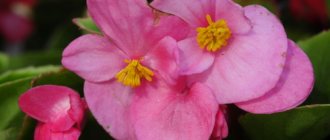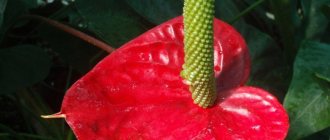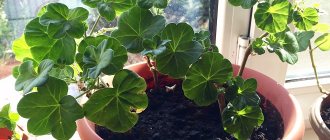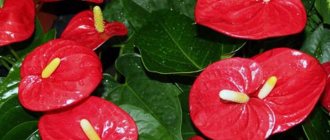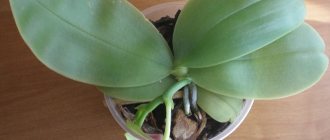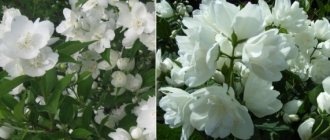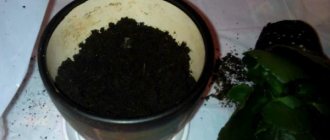When should zygocactus bloom?
In nature, the Christmas cactus can bloom from October to March, depending on the rainy season. The Decembrist is actively preparing for the formation of buds after it has accumulated enough moisture that tropical showers bring.
Since such a climate is not typical for our latitudes, in the summer the plant is watered more abundantly so that when cold weather arrives it has enough strength to form flower buds.
Normally, the Decembrist blooms once a year, because preparing for the laying of future inflorescences requires a lot of resources and depletes it. However, the plant can delight the owner with fresh buds several times between November and February, if good conditions have been created for it.
Vaccination
The method is very popular, since if you place its spreading crown on the trunk of another deciduous cactus (for example, pereskia or pereskiopsis), you get a standard tree that looks very impressive in the interior.
The grafting process is very painstaking and has a number of features.
A segment is selected on one of the Schlumbergera branches, which will become the grafting material. In the place where it grows from the previous segment, you need to cut off the sides with a sharp knife, giving the segment the appearance of a triangle, the acute angle of which is directed towards the previous segment. Leave the Decembrist for several days
During this time, the wounds will heal, and the damaged segment will get used to existing in conditions of limited nutrition, when communication between it and the rest of the Schlumbergera is difficult.
Attention! Sections must be treated with crushed coal or sulfur powder, because Zygocactus wounds can become infected.
The trunk of the rootstock plant is cut, and the cut site is split to a depth of 1-2 cm
All instruments must be disinfected. Pinch off the prepared Decembrist segment with your hands and insert the rootstock plant into the split.
For fixation, use a needle, thread or thorn if it is used as a rootstock. The grafting site should be treated with charcoal or sulfur powder and a bag should be placed over the grafted segment to prevent drying out.
Schlumbergera may wilt and wrinkle in the first days after vaccination. But, if the operation was successful, then soon the plant comes to life and begins to grow new segments. This takes approximately 2-3 weeks.
Reasons why Decembrist does not bloom at home
Problems with the microclimate
Schlumbergera is a representative of the tropics. In order for her to feel comfortable in a city apartment, far from her natural habitat, you need to create an environment close to the climate of a humid and warm forest. Zygocactus loves diffused sunlight, so you need to take care of a suitable place for it.
Even in summer, the plant reacts painfully to direct and intense sunlight, so it is better to protect the surface of the leaves from such light.
Although the Decembrist is a cactus, it is acutely sensitive to a lack or excess of water. To maintain optimal conditions for plant development, you need to carefully monitor the temperature and humidity level in the room. Schlumbergera is a succulent, which means it can store water in special tissues, but this is not enough.
Developed aerial roots solve this problem - they absorb liquid from the air. To achieve a favorable microclimate, you can place the container with the flower on wet gravel or expanded clay.
Watering should be moderate and should be done only after the top layers of the soil have dried. Settled water at room temperature is ideal. It would also be useful to spray the plant, as well as a warm shower once a week.
Schlumbergera needs fresh air circulation, so it is not grown in stuffy or poorly ventilated areas. Maintaining a favorable background is a necessary condition for the active growth of zygocactus.
No rest period
Even if an ideal microclimate is created for the Decembrist, it may not please its owner with lush flowering. This happens because temperature and humidity indicators must change at different periods of time. With the arrival of late autumn, Schlumbergera slows down its metabolic processes, as preparation for the energy-consuming period of flowering begins.
At this time, you need to reduce watering and place the pot with the plant in a dark place to limit the amount of light it receives. The Christmas tree will not experience stress about this if you reduce the volume of spraying and fertilizing gradually, before stopping them altogether.
The optimal temperature for the plant during this period is 12-14°C.
Such events will help the Decembrist prepare for the flowering phase, and on the eve of the holidays he will be able to release the long-awaited buds.
Wrong potty
In order for the Christmas cactus to bloom magnificently, you do not need to choose a larger and wider flowerpot, guided by the fact that it needs a lot of space to grow. Schlumbergera has a small and loose root system, so it is advisable to choose a medium-sized flower pot - not too tall so that the plant does not spend all its energy filling the free space, but not too narrow so that it has room to grow.
The soil for the Christmas tree can be taken from the garden plot or you can buy a special substrate for cacti - this is not so important. The main thing is to apply proper fertilizers and make a good drainage system to remove excess moisture and protect the roots from rotting.
Injured during transplantation
The Christmas cactus has a very fragile root system, so replanting can result in stress for the indoor plant. After any manipulations, it is necessary to provide the Decembrist with peace and give him time to adapt to new conditions.
Schlumbergera is not watered for 3-4 days after transplantation - this is necessary so that the injured roots heal. Feeding is stopped for a period of 1 to 2 months. The pot with the plant is placed in a shaded and cool place until it returns to normal and begins to sprout new leaves and shoots.
If the roots of the Decembrist have suffered from concentrated fertilizers or hypothermia, another transplant may be necessary.
Diseases and pests
Despite the fact that zygocactus is quite resistant to fungal diseases, they can still be an unpleasant find for any gardener. The pathogens of late blight and phythium penetrate the soil and infect it, causing the already weak root system of Schlumbergera to suffer.
The first signs of diseases can be seen at the root part - plant segments in this zone change color, wither and fall off.
Fusarium pathogens enter the plant through affected areas on leaves or stems. The flower becomes pale, withers and loses segments. If you treat the resulting wounds with wood ash, the entrance to harmful microorganisms will be sealed.
To treat a Decembrist already infected with fungal diseases, various fungicides are used.
Parasitic insects also cause a lot of inconvenience - the plant begins to grow poorly, fades and withers. A sudden coating of rust on the shoots is a trace of spider mites, which appear on the Christmas tree due to lack of moisture. Mealybugs are another pest that leave behind white clumps that look like cotton wool.
To combat these parasites, various drugs are used - Neoron, Aktaru, Fitoverm.
If the Decembrist is covered with small brown dots, then the problem is with scale insects - small insects that suck the juice from the leaves. To get rid of them, you need to wipe the leaves well with a soapy cloth and spray them with an insecticidal agent.
Another unpleasant insect is the mite, which causes the leaves to die and yellow and black spots to appear on them. Pests can only be seen with a magnifying glass. If mites are found, wipe the zygocactus leaves with a soapy sponge and wash with hot water (50°C).
The buds and flowers are cut off, and the plant is sprayed with insecticides.
The Christmas tree requires constant attention - regular inspection of the plant will help identify parasites or diseases that have not yet caused irreparable harm.
Constant rearrangement of the flower
Schlumberger is capricious about moving from place to place; for this plant, you need to create favorable conditions and leave it alone. Even turning the pot can have a negative impact on the Christmas cactus, especially during the active flowering phase.
Little fertilizer or watering
Zygocactus does not need fertilizer during bud opening and dormancy, but from February to September, fertilizing is necessary to saturate the plant with nutrients.
In addition, mineral compositions and complex mixtures help the sensitive Decembrist painlessly adapt to changing climatic conditions. A lack of vitamins and moisture can negatively affect the intensity of flowering.
Rare transplant
The most favorable time to transplant Schlumbergera is immediately after flowering, usually at the end of February. Young plants are replanted every year for the first 3 years. Afterwards, transplantation is carried out every 4-5 years or as needed. Decembrist grows slowly, so sometimes it is enough just to carefully replace the top layer of soil in the flowerpot.
How to choose a place and soil for a Decembrist flower
The flower prefers well-lit places or light shading, but does not like direct sunlight. The best place for it in an apartment is the eastern (less often, northern) window.
Since Schlumbergera naturally lives in the Brazilian tropical forests, attaching itself to tree branches, it does not have any special requirements for the composition of the soil. However, experienced flower growers claim that Decembrist grows best in soil consisting of a mixture for cacti, peat, a small amount of sphagnum and the same - expanded clay, sand and leaf humus. The permissible acidity of the soil mixture is pH 6.1-7.8, that is, from slightly acidic to slightly alkaline reaction. It is preferable that this indicator remain within neutral values.
Experts advise immediately choosing a strictly defined place for the Decembrist and not moving the plant anywhere in the future, as this may affect its “well-being.”
We hold events so that the Decembrist blooms
If you take good care of your Christmas tree, problems with flowering will disappear on their own. In order for the plant to delight you with a riot of colors in the winter cold, you need to follow several recommendations:
- keep the room cool, avoid drafts and frequent changes in temperature;
- provide enough moisture in the air;
- fertilize the plant in appropriate seasons;
- reduce watering during periods of rest and bud formation, and during flowering, moisten abundantly;
- After the buds appear, do not move or rearrange the vessel with the flower, give it rest.
Why is Schlumberger sluggish?
It is a mistake to think that lethargy of stems indicates a lack of moisture. Everything is completely the opposite - the plant is overwatered. As a result of this, the roots cease to perform their functions of delivering nutrients. The drastic solution will be to replant and remove damaged roots. All cuts are processed with crushed coal.
If the plant is in the flowering stage, then the need for replanting is decided based on the rate of wilting. After the procedure, all buds and flowers will fall off.
Slightly wilted leaves can be revived without replanting. It is enough to wait a little while watering and place the flower closer to the heating device. Every day it is necessary to monitor the degree of drying of the earthen clod.
Common mistakes beginners make when growing
Many difficulties can be avoided if you properly organize the care of your Christmas cactus. When creating a microclimate, it is necessary to take into account the characteristics of the plant and the season. Beginners often do not know or ignore recommendations for caring for the Decembrist. Caring for an exotic flower, although not difficult, requires attention to detail.
Common mistakes:
- too rare or frequent watering;
- the use of hard water for irrigation, as evidenced by a white coating on the soil and walls of the pot;
- excess fertilizer, leading to discoloration and curvature of leaves;
- insufficient air humidification, stimulating the active formation of aerial roots;
- unfavorable room temperature.
Plant species
In total, several species of Schlumbergera have been discovered. But there are very, very many hybrids and plant varieties. And this list is constantly growing due to the appearance of new copies. But we will list only the most basic varieties of Decembrist.
- Schlumbergera truncatus (truncated). The growth of an adult plant reaches half a meter. The stalks are long (up to 300 mm) and consist of several segments with pronounced teeth. The flowering plant is completely covered with clusters of flowers of white, pinkish, lilac or violet color. In their place, small fruits of a bright red hue are subsequently formed.
- Schlumbergera bucklei (bucklei). This zygocactus is less tall than the previous Decembrist variety. The stems are branched, dark green, shiny. There are no spines, instead there is a light edge. The flowers are large – up to 80 mm, in different shades. You can purchase yellow varieties of this variety of Christmas tree.
- Schlumbergera Russelliana (Russelliana). Small cactus up to 300 mm in height. The stems are well developed, without thorns, divided into flattened shiny segments. The plant is grown in hanging pots, since the shoots can reach a length of 100 cm. The flowers are large, their color can be reddish, pinkish, carmine or purple.
- Schlumbergera gaertneri (Gertner). This zygocactus is quite large. The stem segments alone can reach 60-70 mm in length. The main feature of this type of Decembrist is the huge buds that resemble bells with pointed petals. The color of the flowers is bright red with an orange tint.
- Schlumbergera opuntioides (prickly pear). As the name suggests, the plant is very similar to prickly pear, that is, a cactus. The stem segments are very fleshy and covered with spines. During the flowering period (early spring), this variety of Decembrist is also covered with pink-violet buds.
If you want to please yourself with bolder and more unusual varieties of Schlumbergera, then start growing hybrid varieties. The most popular include Madonna Dance, Madama Butterfly, Pasadena, Golden Cream. The beauty of their flowers will amaze all lovers of house plants.
How to care at different times of the year
November-February
Flowering period. They stop spraying the plant after the first flowers appear, however, increase the frequency of watering.
No fertilizing is used, the container with Decembrist is not moved or moved. The ideal temperature is 16-18°C.
March-August
Growing season. At this time, the plant is actively growing rhizomes and greenery. With the onset of warmth, it is better to take the flower pot out into the open air and leave it in light shade.
Water and spray Schlumbergera moderately as the top layer of soil dries. Fertilizers are applied once every 3-4 weeks. The temperature is maintained at 20-23°C.
September
From the beginning of September, the volume of watering and fertilizing is gradually reduced until it stops completely - this is necessary so that the plant enters the resting phase without stress. Zygocactus is placed in a cool, dark place. Temperature range from 13°C to 15°C.
October
Rest stage. In October, buds begin to form and prepare for flowering. In late autumn, the plant is removed to a dark place. Watering is carried out in extreme cases, do not feed. The temperature is reduced to 12-14°C.
What to feed?
The soil in which Schlumbergera grows becomes depleted over time and cannot restore its nutritional qualities naturally at home. It is possible to give the plant the nutrition it needs for growth, development and flowering only through regular fertilizing.
You need to choose fertilizer depending on the season of the year. So, in the spring-summer period, good growth of Decembrist branches and leaves is necessary, so it is worth using fertilizers containing nitrogen every 2 weeks, which promote the growth of the green mass of the flower.
They can be used until the end of August. With the onset of autumn, you need to stop applying fertilizers so that the Decembrist can rest.
When the first buds appear on Schlumberger, you need to start a new series of fertilizing. During this period, you can use any fertilizer for flowering indoor plants and cacti, the main thing is to exclude nitrogen-containing ones
This is an important condition, because when flowering, the Decembrist does not need to grow new stems and leaves. Otherwise, the flower will grow greatly, but will not begin to bloom.
You can feed zygocactus with fertilizers you make yourself:
- Dilute 2 tablespoons of crushed ash in 1 liter of water and water the flower with the resulting solution.
- Prepare a solution for watering by diluting 1 tablespoon of sugar in 0.5 liters of water.
- Pour 1 part of chopped tangerine, orange, lemon peels with three parts of boiling water, leave for 24 hours, strain and dilute every half liter of infusion with half a liter of water and water the plant.
- Dissolve 2 tablespoons of yeast and 1 tablespoon of sugar in 1 liter of warm water, leave for 2 hours, then dilute each part of the infusion with five parts of water.
You can also use highly diluted mullein.
Prevention
Poor growth of zygocactus and failure to flower are always associated with errors in maintenance and care. Such a capricious exotic plant always signals that conditions are not good enough, and the owner can only notice such messages and respond to them.
In order for the plant to bloom and delight with its colors for many years, you need to carefully monitor the microclimate, nutrition and light. Decembrist requires certain conditions in different seasons - from abundant watering in warm weather to its complete cessation in October.
To prevent diseases, weak growth, and poor flowering, it is important to follow the recommendations and adhere to the regime, then the Christmas tree will definitely delight you with its beauty, health and splendor for many years.


